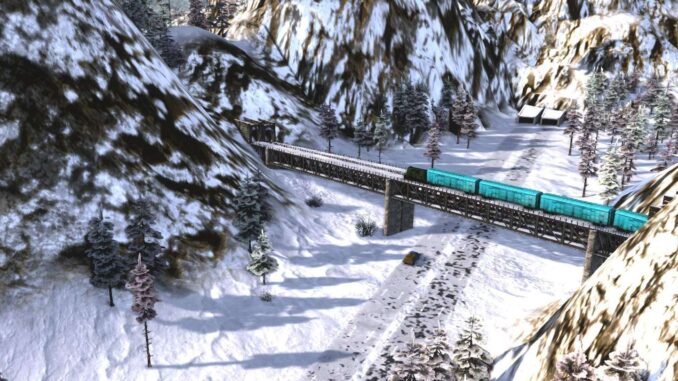
This guide will hopefully give you enough information about the game’s heating system that you can set up a heating network to survive the snowy embrace of winter.
Especially useful right now as there is currently no ingame tutorial for this system.
Surviving Winter
Introduction
The heating system in W&R works very similarly to the electricity system.
You have a heat plant where workers burn coal to create heat in form of hot water. You pipe this hot water around using pipelines that are ultimately connected to heat exchanger buildings, which function pretty much like electrical substations and deliver the heat water to all buildings in a radius around them.
Heating will only be required in your game, when you have both seasons and power management enabled in your game settings.
Note that old city houses, which you can find pre-existing on maps, can heat themselves, however, they will produce a small amount of pollution around them when they do it.
And yes, you’re gonna need to heat your factories and grocery stores, too. The only work places that don’t need heating are mines, quarries, fields, woodcutters and construction sites.
Basic Information
When you click on a building that requires heating, you will find these two gauges at the bottom of its info screen:

Room temperature – Below 15°C people will get happiness penalties, even lower and it becomes a severe danger to their health. You should try to always have it maxed at 24°C.
The round gauge on the right actually gives you two different pieces of information:
- The capacity of the building’s heat water tank – Measured in m³, L for buildings and hL for pipelines. 1 m³ = 1000 L = 10 hL. It’s kinda similar to wattage.
- The temperature of the building’s heat water – The hotter this is, the easier it will be to heat the building’s room temperature.
Heat Water Tank Capacity
The water tank capacity value serves a similar purpose to wattage in the electricity system.
Every building that can be heated has a built in heat water tank with a volume depending on the size of the building. You can see the building’s tank volume written inside the water tank gauge and in the tooltip when selecting the building for construction.
Heat plants and heat exchangers also have values for water tank volume, but these tell you how much volume of water the plant and exchanger can heat efficiently.
To check if you are trying to heat more than what your exchanger or plant are capable of, you need to click on all the buildings that your exchanger/plant is connected to, sum up all the tank volumes of these buildings and then compare the total number to the capacity of your exchanger/plant.
Here is an example. This big heat exchanger is connected to a couple flats, a kindergarten, hospital and a big shopping centre. The combined water tank volume of these buildings is 129 m³, which is less than the exchanger’s capacity of 300 m³. See how this tiny district would already be too much volume for a small heat exchanger.
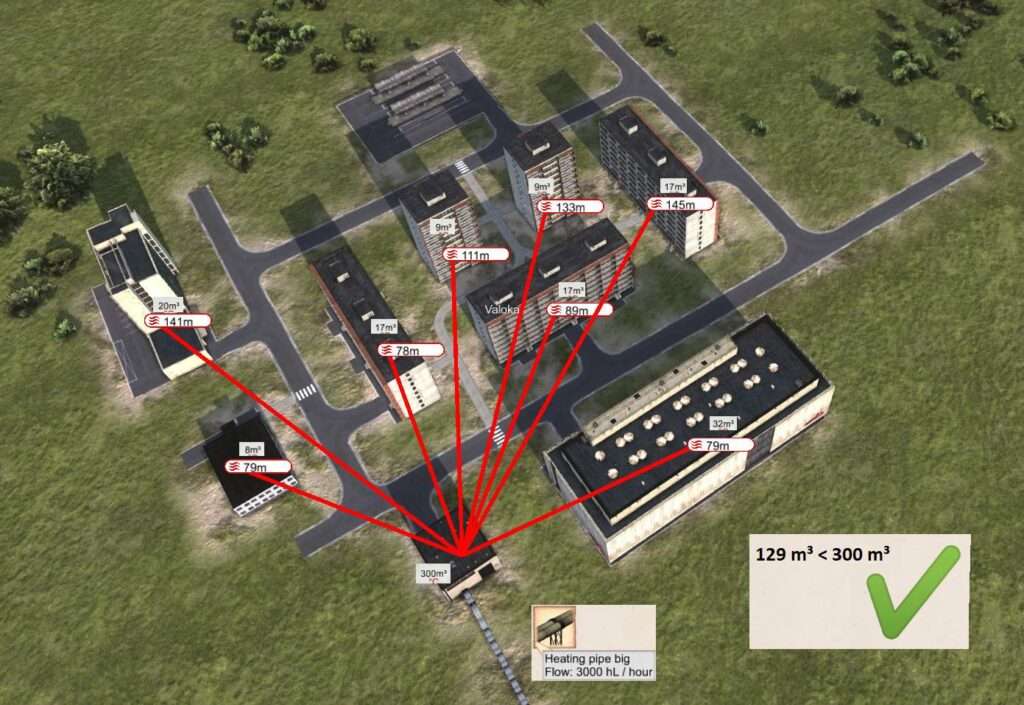
Keep in mind that water tank capacity is not the only factor that determines if your heating network is capable of heating your buildings. It doesn’t 100% guarantee maximum water temperature in all situations, but it is a useful guideline that you shouldn’t ignore.
Heat Water Temperature
The heat water temperature can go up to 90°C. You always want this to be as high as possible.
You need to keep two things in mind:
First, it takes time for your heat water network to heat up. That means you can’t just hook up a heating plant and expect all connected buildings to immediately be livable. In other words, you need to be ready BEFORE winter. Trying to kickstart a heating system during winter requires you to throw a lot of bodies at the problem.
Second, if you see that your water temperatures are really good in summer, it doesn’t mean that you are necessarily prepared for winter. Outside temperature has a big impact on the ability for your heat plants to heat up the water. If you set up your heating in an inadequate way, it might take until winter for you to realise it. And by then you might already be trapped in a death spiral.
The way the temperature of the heat water is calculated is actually pretty complex and depends on many factors. The water tank capacity, the outside temperature, the heating power of the heat plant, the power consumption of the buildings, etc.
Pipelines, Pumping Stations and Bottlenecks
Pipelines come in two sizes, small and big. The small ones handle 100 m³ of water (same as a small heat exchanger) and the big ones 300 m³ (same as a big heat exchanger). Small pipelines can actually be connected to big pipeline connectors, too, but it is recommended that you use big pipelines whenever its possible.
Pipelines have a maximum range. Pumping stations are used to extend this range.
Be careful with bottlenecks. Don’t use a pumping station to connect three big heat exchangers to a single big pipeline. This would severely limit the heating power of your heat network.
Don’t do this, this is a bottleneck:
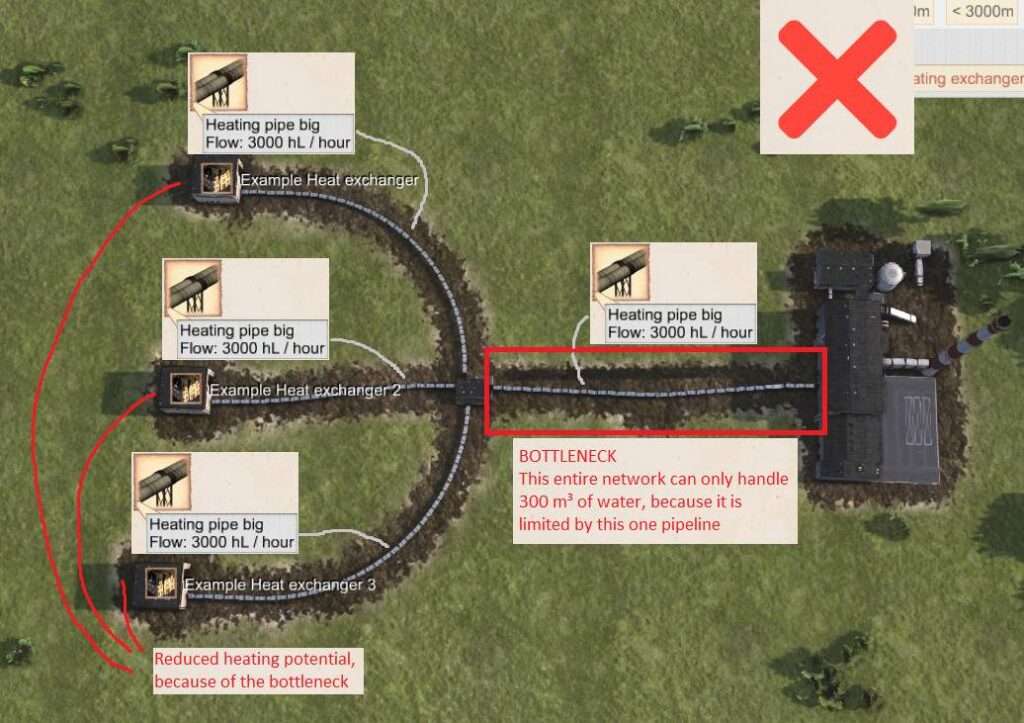
Instead, make sure that you have 1 pipeline per heat exchanger, like this:

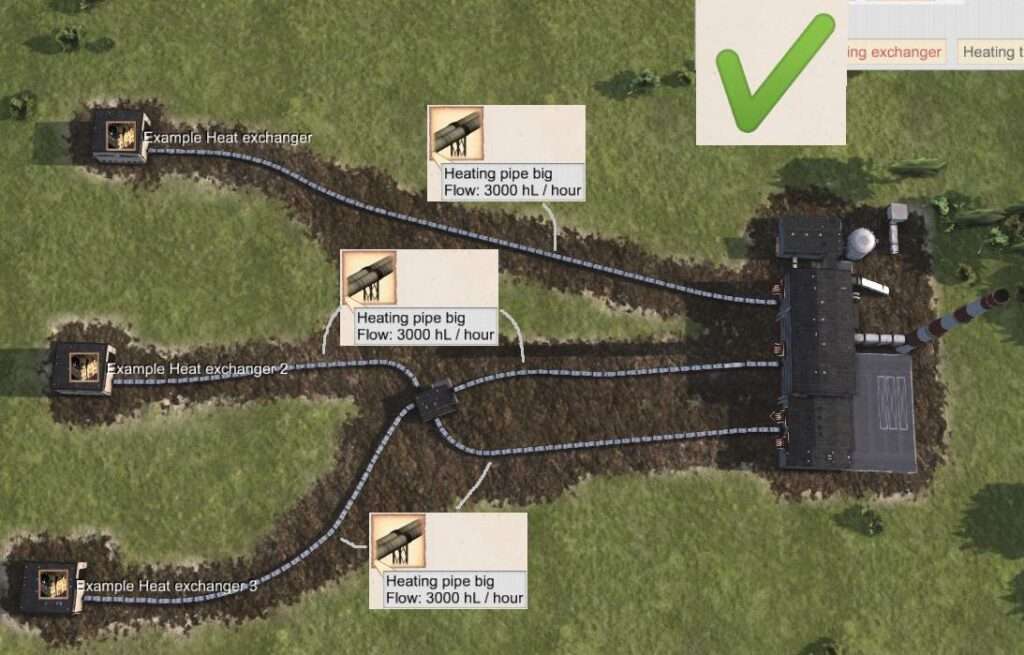
In this example, I’m dividing a big pipeline up into 3 small pipelines, this is also okay to do, but keep in mind that you shouldn’t really be heating your city with small heat exchangers, unless it’s a very rural city:
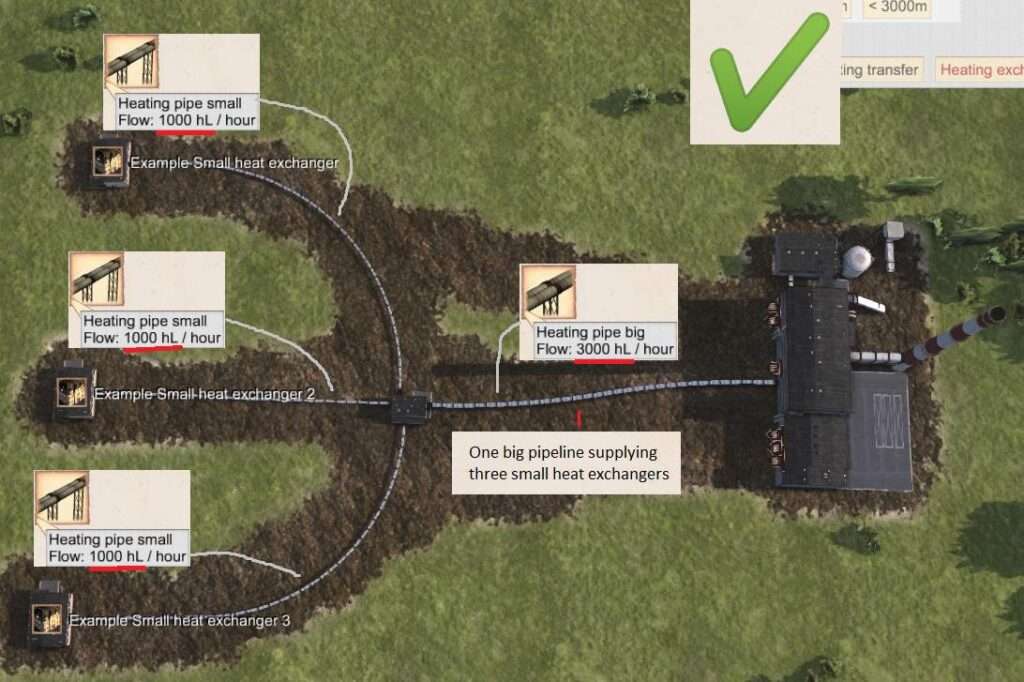
Heating Plants
Heating plants consume coal and also come in two sizes, small and big. A small heating plant has a water tank capacity of 210 m³, which is enough for slightly more than 2 small heat exchangers. A big one has 1050 m³, which is enough for slightly more than 3 big heat exchangers as well as 1 small one.
Just like power plants though, heating plants also function as a heat exchanger themselves for buildings that are close to them. Be wary of that, when you try to calculate how much water volume a plant is connected to in total.
It is recommended that you use the big heating plant and big heat exchangers to heat your cities, but small ones might be good enough for industry and rural towns.
It is very important that your heating plant is always supplied with workers, just like your power plant. If your heating plant or power plant ever run out of workers, the temperature of your heat water is going to decrease and this can potentially turn into a very deadly problem.
Try bringing workers to these plants using lots of small microbuses to ensure there’s always someone working. Alternatively you could try a cableway. Cableways are surprisingly good at supplying work places with a steady stream of workers.
Another thing to mention is that the heat production of the heat plant is measured in gigajoules, but in my opinion, you can just ignore that. The better indicator to pay attention to is the heat water tank capacity.
Summary
- Be prepared. Set up your heating network while it’s still warm outside.
- Avoid pipeline bottlenecks. Give each exchanger their own pipeline connection to the heat plant.
- Don’t go over the water tank capacity. If your heat exchanger or heat plant are connected to more water tank volume than their capacity, build additional ones.
- Always have workers in your heat plant. Same with your power plant.


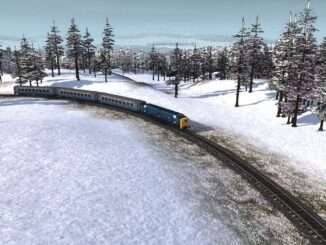
I checked some numbers: you lose 0.7 Celsius each 50 meters underground up to 1km (max length of pipe without pump). You lose 1.2 Celsius overground in a 1km. After the first pump the drop isn’t linear. It seems again 0,7 each 50 meters both over or underground. After the second pump it’s non linear and I need more trials to check it.
If you pass underground in a populated area, already heated, the drop is much similar to overground pipes in the first km.
Thanks for the guide. It was much needed !
Hi,
Thanks for the nice Guide, very much usable here.
Another unsolved mystery to this topic: Which setup is to use to get maximum temperature to the exchanger?
Factors are:
-Total Length of pipeline(s)
-Number of pumps used
-Position of pumps (distance to plant and exchanger)
I figured out that in a pipeline of the same length the temperature behaves like:
1 pump > no pumps > 3 pumps
Also it seems to be:
1 pump close to the plant > 1 pump close to the exchanger
But there is strange behaviour to this I cannot explain myself. I made a (german) video to this (https://www.youtube.com/watch?v=-5OgDvC0-s8), maybe you have an idea how the exact mechanic works?
I play without auto-build and had many bad surprises when I built my setup and got 60°C water in my vital exchanger…